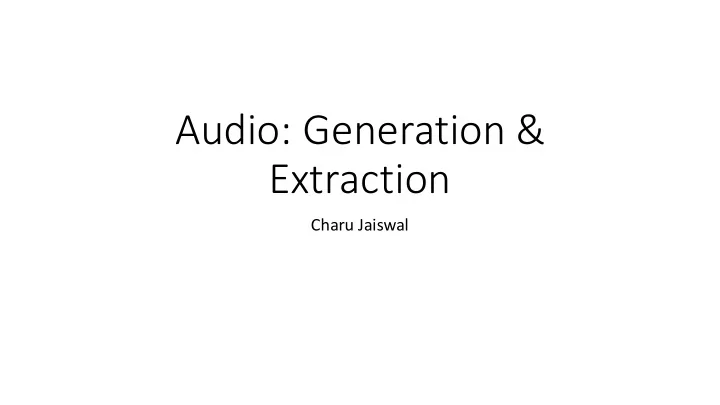

Audio: Generation & Extraction Charu Jaiswal
Music Composition – which approach? • Feed forward NN can’t store information about past (or keep track of position in song) • RNN as a single step predictor struggle with composition, too • Vanishing gradients means error flow vanishes or grows exponentially • Network can’t deal with long-term dependencies • But music is all about long-term dependencies! 2
Music • Long-term dependencies define style: • Spanning bars and notes contribute to metrical and phrasal structure • How do we introduce structure at multiple levels? • Eck and Schmidhuber à LSTM 3
Why LSTM ? • Designed to obtain constant error flow through time • Protect error from perturbations • Uses linear units to overcome decay problems with RNN • Input gate: protects flow from perturbation by irrelevant inputs • Output gate: protects other units from perturbation from irrelevant memory • Forget gate: reset memory cell when content is obsolete Hochreiter & Schmidhuber, 1997 4
Data Representation Chords : Only quarter notes No rests Notes: Training melodies written by Eck Dataset of 4096 segments Eck and Schmidhuber, 2002 5
Experiment 1- Learning Chords • Objective: show that LSTM can learn/represent chord structure in the absence of melody • Network: • 4 cell blocks w/ 2 cells each are fully connected to each other + input • Output layer is fully connected to all cells and to input layer • Training & testing: predict probability of a note being on or off • Use network predictions for ensuing time steps with decision threshold • CAVEAT: treat outputs as statistically independent. This is untrue! (Issue #1) • Result: generated chord sequences 6
Experiment 2 – Learning Melody and Chords • Can LSTM learn chord & melody structure, and use these structures for composition? • Network: • Difference for ex1. : chord cell blocks have recurrent connections to themselves + melody; melody cell blocks are only recurrently connected to melody • Training: predict probability for a note to be on or off 7
Sample composition • Training set: http://people.idsia.ch/~juergen/blues/train.32.mp3 • Chord + melody sample: http://people.idsia.ch/~juergen/blues/lstm_0224_1510.32.mp3 8
Issues • No objective way to judge quality of compositions • Repetition and similarity to training set • Considered notes to be independent • Limited to quarter notes + no rests • Uses symbolic representations (modified sheet notation) à how could it handle real—time performance music (MIDI or audio) • Would allow interaction (live improvisation) 9
Audio Extraction (source separation) • How do we separate sources? • Engineering approach: decompose mixed audio signal into spectrogram, assign time-frequency element to source • Ideal binary mask: each element is attributed to source with largest magnitude in the source spectrogram • This is then used to est. reference separation 10
DNN Approach • Dataset: 63 pop songs (50 for training) • binary mask computed: determined by comparing magnitudes of vocal/non- vocal spectrograms and assigning mask a ‘1’ when vocal had greater mag 11
DNN • Trained a feed-forward DNN to predict binary masks for separating vocal and non-vocal signals for a song • Spectrogram window was unpacked into a vector • Probabilistic binary mask: testing used sliding window, and output of model described predictions of binary mask in sliding window format • Confidence threshhold(alpha): Mv binary mask 12
Separation of sources using DNN 13
Separation quality as a function of alpha SIR (red) = signal-to- interference ratio SDR(green) = signal-to- distortion SAR(blue) = signal-to- artefact SAR and SIR can be interpreted as energetic equivalents of positive hit rate (SIR) and false positive rate (SAR) 14
Like-to-like Comparison Plots mean SAR as a function of mean SIR for both models DNN provides ~3dB better SAR performance for a given SIR index mean, ~5dB for vocal and and only a small advantage for non-vocal signals DNN seems to have biased its learnings toward making good predictions via correct positive identification of vocal sounds 15
Critique of Paper + Next Steps • DNN seems to have biased its learnings toward making good predictions via correct positive identification of vocal sounds • Only a small advantage to using DNN vs. traditional approach • Expand data set 16
Recommend
More recommend